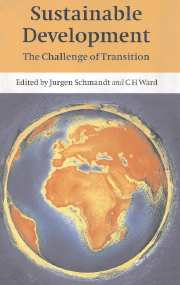Book contents
- Frontmatter
- Contents
- List of contributors
- Foreword
- Preface
- 1 Challenge and response
- 2 National self-interest in the pursuit of sustainable development
- 3 Uneconomic growth: Empty-world versus full-world economics
- 4 Population and consumption: From more to enough
- 5 Spirituality and sustainability
- 6 Leadership skills for sustainable development
- 7 The role of science: Guidance and service
- 8 Economic tools, international trade, and the role of business
- 9 Stakeholders and sustainable development
- 10 From idea to action: The role of policy
- Index
10 - From idea to action: The role of policy
Published online by Cambridge University Press: 17 August 2009
- Frontmatter
- Contents
- List of contributors
- Foreword
- Preface
- 1 Challenge and response
- 2 National self-interest in the pursuit of sustainable development
- 3 Uneconomic growth: Empty-world versus full-world economics
- 4 Population and consumption: From more to enough
- 5 Spirituality and sustainability
- 6 Leadership skills for sustainable development
- 7 The role of science: Guidance and service
- 8 Economic tools, international trade, and the role of business
- 9 Stakeholders and sustainable development
- 10 From idea to action: The role of policy
- Index
Summary
Is development, as we know it, unsustainable? If so, can it be made sustainable? Can regions, nations, and the world as a whole reach a durable balance between economic, social, and environmental priorities? As we prepare for the twenty-first century, what role in reaching this goal can be played by the market and what must the state do? These are central questions in the debate on sustainable development. They are addressed, directly or indirectly, in most of the preceding chapters. Different answers emerge. I will attempt to summarize them in two contrasting views, one radical, the other incremental.
The radical view argues that sustainable development must be development without quantitative growth, the opposite of development as we know it. Why is radical change needed? Because business as usual will exhaust natural resources, overload the carrying capacity of natural systems, land, air, and oceans, and eventually lead to the collapse of human societies worldwide. The superbly successful engine that drove development since the beginning of the industrial revolution more than two centuries ago now carries in it the seeds of destruction. Maximizing income, profit and consumption are becoming counter-productive. Living in a full world the same way we lived in an empty world will be suicidal.
The radical perspective believes that sustainable development can prevent this outcome. It offers a prudent alternative to self-destruction. It does so by respecting the needs of coming generations, balancing economic with environmental concerns, reducing consumption in rich countries, and alleviating poverty in poor countries. These measures, once widely implemented, will guarantee the survival of the species.
- Type
- Chapter
- Information
- Sustainable DevelopmentThe Challenge of Transition, pp. 203 - 220Publisher: Cambridge University PressPrint publication year: 2000



